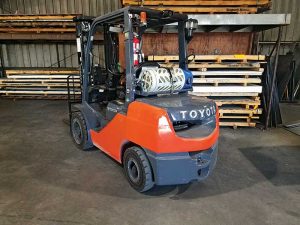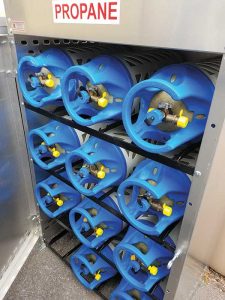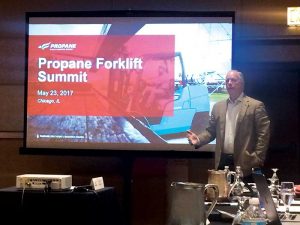Facing challenges in the forklift market
Commerce has boomed in Atlanta over the past few years, as a number of companies have moved their headquarters to the city and its surrounding communities.
Mark Dmochowski, sales manager at Georgia Gas Distributors, has noticed a rise in warehouse distribution centers being built in the city. Atlanta has become somewhat of a distribution hub for the southeastern United States, he says.
The construction of new distribution facilities means an increased need for forklifts. That’s a positive factor, as the forklift market provides more than 500 million gallons in sales to the propane industry annually, according to the Propane Education & Research Council (PERC).
The downside to the growth of distribution centers in Atlanta is that many of these facilities prefer to use electric-powered forklifts instead of internal combustion (IC) forklifts, which include propane, gasoline and diesel models.
“The new warehouses and distribution facilities coming to the area are geared toward e-commerce,” Dmochowski says. “That means the facilities have narrow aisles and tall shelving, which is the electric forklift environment. That’s the nature of the beast.”
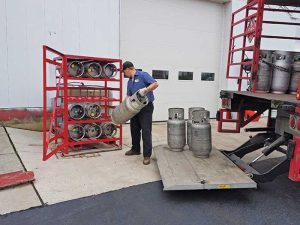
Propane forklift market sales amount to about 500 million gallons. Photo courtesy of Boehlke Bottled Gas
It’s not just Atlanta where facilities are choosing electric forklifts. Propane units have experienced losses over the past five years to electric. This trend is leading industry stakeholders to explore new ways to reverse the downtrend and revive lost gallon sales in a traditionally strong propane demand area.
Although forklift sales have been rising with today’s improving economy, much of the demand for forklifts can also be attributed to the rise in third-party logistics companies and warehouse distribution centers being built in the U.S., according to James J. Radous III, president of UniCarriers Americas Corp., a forklift manufacturer. This demand is directly tied to online retail sales growth, which is eclipsing brick-and-mortar shops, he adds.
“It’s been trending that way the last five to six years,” Radous says. “We’ve been following this trend, and it’s becoming more dramatic because of larger warehouse applications going up – like Amazon – and they want electric.”
With that trend, about two-thirds of forklift owners use electric models, according to PERC. Increasingly forklift owners have been leaning toward electric models over IC models. While some applications, such as warehouses with narrow aisles, require electric forklifts due to the technical capabilities of these models, companies are also leaning toward electric models for other applications due to perceived emissions benefits.
Despite the electric model’s gains over IC models, the propane industry still has opportunities to further secure its place in this market and regain market share lost to electric. Among all IC models, propane serves as the dominant fuel type, PERC says. Propane forklift models also offer advantages in outdoor applications, such as lumber, trucking and transportation.
Shocking switch
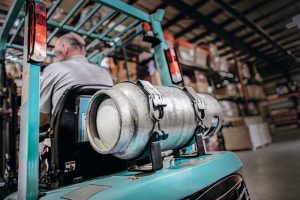
Propane is the top fuel among internal combustion model forklifts. Photo courtesy of the Propane Education & Research Council
It’s not unusual for propane forklift customers to switch to electric models long before they inform their propane retailer of that decision, according to a number of retailers who service this market. And by that point, it’s often too late for the retailer to convince the customer to reinvest in propane forklifts.
“Every once in a while, we’ll get a customer who is making a change,” says Chad Kroening, fleet and projects manager at Boehlke Bottled Gas. “They might call and tell us, and we’ll know we then have to compete against electric or diesel. But it’s not often. That’s maybe one out of a hundred cases.”
Sometimes forklift users switch to electric models because electric works better for their application. Traditionally, electric serves as a better option among food service companies, logistics companies and indoor warehouses. Propane forklifts don’t work as well in environments with narrow aisles, high stacking heights and strict indoor emissions standards.
“We don’t have a product that fits in that market space,” says Jeremy Wishart, deputy director of business development at PERC. “The models that fit in narrow aisle setups are often quite small where someone stands on a platform that can go up and down. They fit in a tightly controlled environment, and we don’t have a product that fits that need.”
Other times companies switch to electric models because those models require less maintenance than propane forklifts, leading to lower maintenance costs. Still, other companies switch to electric models because management at the company is told it’s a cheaper, cleaner option than propane. However, this may not be the case in all instances because electric batteries can be challenging to recycle when they need to be disposed, Radous says.
“There’s the notion that electric models appear to be more green,” he says. “But it might not be true because battery disposal is an environmental issue.”
Then some companies switch to electric as a result of decisions made at the corporate level to meet stricter emissions regulations.
“Regulation is probably the big issue for us, as far as drawing the market with new gallons,” Kroening adds. “Some of the biggest challenges we face are regulatory challenges where we’ve got a certain end user that is mandated to go with electric instead of propane.”
Yet possibly the biggest advantage electric has over propane today is the fact that its industry has better communication efforts with the forklift and material handling industries than the propane industry, according to PERC.
Talking points
Dmochowski once received a brochure from an electric battery manufacturer that touted electric forklifts over IC forklifts. The brochure included a cost savings calculator that showed how electric forklifts only cost about 10 cents per kilowatt-hour. Dmochowski connected with one of his bigger customers that uses both electric and propane forklifts to gauge the accuracy of the brochure’s calculator.
“He emailed me back and said his [electric models] didn’t equate to what the brochure said,” he says. “You plug his actual information into the cost calculator in the brochure and there was no advantage to switching to electric based on cost.”
Although the electric battery manufacturer’s brochure featured one-sided data, it still provided the battery manufacturer with a simple way to market its product. However, the propane industry seems to fall behind with regard to marketing materials in the forklift market, Dmochowski says.
“We don’t do a very good job communicating the positive aspects of running propane forklifts,” he adds. “We need to get more serious about putting together a good story to tell this market.”
PERC also recognizes the need for rebranding efforts that will allow propane forklifts to compete against electric forklifts and secure their place in the market. The council released a survey that shares propane’s advantages in the forklift market during the 2017 Southeastern Convention & International Propane Expo. Yet PERC also sees a need for rebranding among forklift dealers, distributors and users if the industry hopes for market success.
“There seems to be a fairly consistent gap between propane and electric forklift sales,” says Tucker Perkins, PERC’s president and CEO. “When I travel, I don’t feel like anyone has their selling game on to combat with electric. Is it a technology issue we have [in this market]? Probably not, but we need to work on that. Is it a communication issue we have [in this market]? Probably so, and we have to work on it.”
Some retailers invested in this market are aware of the need to improve communication efforts with forklift users and dealers in order to combat losses to electric forklifts.
Bill Mayo, southeastern account manager at ThompsonGas, noticed this need after one of the company’s large manufacturer customers reduced its fleet of propane forklifts by 40 percent – from 65 percent to 25 percent.
“We obviously need to turn this around,” Mayo adds. “The industry as a whole has to educate forklift dealers and win them over to propane instead of electric.”
PERC’s survey offers facts that retailers can share with forklift customers. These include how propane forklifts provide 100 percent power throughout operation and how propane models offer reduced emissions compared with diesel models. The council is also developing case studies to boost awareness of propane’s presence in this market segment.
Radous agrees that propane needs to rebrand and improve communication efforts with forklift users, dealers and manufacturers to ensure its place in the material handling market. There are cases where electric applies better than propane, but propane shouldn’t lose to electric where it serves as a better application, such as outdoors, he adds.
“There has to be further education on why propane is a good alternative,” Radous says. “Users think electricity is very clean, but if you’re working with batteries, they aren’t always clean. The fact that it takes eight hours to charge a battery and five minutes to replace a propane tank also provides flexibility advantages to the customer who seeks uptime.”
Lift in technology, service
In addition to boosting communication efforts among forklift users about the benefits of propane, new propane forklift technologies also give propane a lift in this market. To date, the latest technology available for propane forklifts is based on electronic fuel injection or port fuel injection.
Electronic or port fuel injection technology allows for a more precise metering of fuel to the engine when compared with simpler carbureted or fumigation systems on older propane forklift engines, according to PERC. Some of the latest models of propane forklift engines include the PSI 4X engine, which debuted in 2016, as well as the PSI 2.0- and 2.4-liter engines, Nissan K21 and K25 engines, Kubota 2.5- and 3.8-liter engines and Crown 2.4-liter engines.
“Think of it as automotive technology making its way into the mobile industrial marketplace,” Wishart adds. “The net result is a more efficient engine in terms of reduced fuel consumption, reduced emissions and increased service intervals.”
Retailers also have opportunities in the forklift market when they provide forklift customers with above-and-beyond service.
“If you get involved in this segment, you must be fully committed to your customers,” Kroening says. “All end users expect a high level of service, so if you drop the ball, you could lose your customer.”
Propane Ninja, a propane cylinder exchange company in Florida, entered the forklift market one year ago, but the company saw a need to provide customers with additional service offerings to keep them committed to propane. Propane Ninja offers its forklift customers with online and in-person safety training on propane forklifts to further ensure trust.
“Most of our customers find this valuable,” says Mike Dodd, owner of Propane Ninja. “My partner is OSHA certified, so he’ll go meet the companies to train them.”
Georgia Gas Distributors also goes an extra step when serving forklift customers, acting as a safety consultant. It teaches its forklift customers on propane safety and OSHA codes.
“There are some misconceptions about what the codes actually are, so we try to give our customers a clear understanding of the regulations and make sure they’re in compliance,” Dmochowski adds. “This is how we can add real value to our services. We all sell the same thing, but it’s value-added services that generate loyalty and will help customers think twice before switching.”
Over 231,000 forklifts sold in 2016
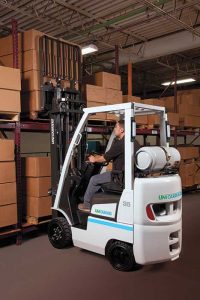
Logistics companies and distribution centers are fueling forklift demand. Photo courtesy of UniCarriers Americas Corp.
The sale of forklifts is rising, according to the Industrial Truck Association (ITA). The industry sold over 231,000 forklifts in 2016 and 226,000 forklifts in 2015 – across the United States, Canada and Mexico. The industry sold only about 98,000 units in 2009 during the Great Recession.
“Our industry is extremely healthy right now,” says Brian Feehan, president of ITA. “Selling anything above 200,000 units is a good market. In 2015, we set a record at 226,000 units sold. Everybody was positive about the market conditions, but nobody expected two consecutive years of record sales.”
ITA anticipates the trend of forklift sales to remain strong through 2019.
2017
■ 66 percent use electric forklifts.
■ 34 percent use internal combustion forklifts, including propane, diesel and gasoline.
2012
■ 52 percent used electric forklifts.
■ 48 percent used internal combustion forklifts, including propane, diesel and gasoline.
Note: About 80 to 90 percent of internal combustion (IC) forklift sales are propane models, according to ITA.
Focus on forklifts
The Propane Education & Research Council (PERC) hosted a forklift market workshop in Chicago to evaluate opportunities and challenges in that market. PERC invited propane marketers and equipment manufacturers to discuss the market.
Comparing challenges, opportunities
The Propane Education & Research Council lists the following as industry challenges and opportunities in the forklift market.
Challenges
■ Threats from electric will continue among all forklift capacity levels.
■ Some users have the negative perception that propane is not clean enough for certain applications.
■ Regulatory issues in California have caused emissions standards to become stricter across the United States.
■ Propane maintenance costs create some concern among users when compared with electric.
■ Corporate mandates are pushing more companies to go with electric instead of diesel.
Opportunities
■ Propane tends to be viewed as a reliable, readily available option.
■ Propane provides 100 percent power in all circumstances.
■ Tier 4 complexities among diesel forklifts have caused more companies to turn to propane forklifts.
■ Some companies are interested in new propane forklift engines and models.
■ Renewed branding, awareness, safety and training campaigns are needed to drive continued awareness of propane’s presence in this market.
Propane gallon opportunities
Total gallon sales attributed to the forklift market average just over 500 million annually, based on data from the past five to seven years, according to the Propane Education & Research Council (PERC). Yet, these numbers are down from highs the industry experienced in this market more than 10 years ago.
Factors contributing to the declines in this market include increased emissions regulations, market shift from heavy industrial manufacturing to warehousing and the continued technology advancements of the electric forklift, PERC adds.
“The opportunity for that to decline or grow is pretty dependent on the propane industry’s level of commitment to continue to invest in this market, go after new opportunities and engage forklift customers or dealers with a product that meets or exceeds their needs,” says Jeremy Wishart, deputy director of business development at PERC.








